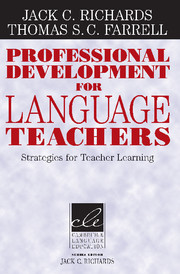Book contents
- Frontmatter
- Contents
- Series editor's preface
- Preface
- 1 The nature of teacher education
- 2 Workshops
- 3 Self-monitoring
- 4 Teacher support groups
- 5 Keeping a teaching journal
- 6 Peer observation
- 7 Teaching portfolios
- 8 Analyzing critical incidents
- 9 Case analysis
- 10 Peer coaching
- 11 Team teaching
- 12 Action research
- Appendix
- Index
8 - Analyzing critical incidents
Published online by Cambridge University Press: 01 February 2010
- Frontmatter
- Contents
- Series editor's preface
- Preface
- 1 The nature of teacher education
- 2 Workshops
- 3 Self-monitoring
- 4 Teacher support groups
- 5 Keeping a teaching journal
- 6 Peer observation
- 7 Teaching portfolios
- 8 Analyzing critical incidents
- 9 Case analysis
- 10 Peer coaching
- 11 Team teaching
- 12 Action research
- Appendix
- Index
Summary
The nature of critical incidents
Acritical incident is an unplanned and unanticipated event that occurs during a lesson and that serves to trigger insights about some aspect of teaching and learning. Critical incident analysis in teaching involves the documentation and analysis of teaching incidents in order to learn from them and improve practice. The following vignette from a teacher in Japan is an example of a critical incident that occurred during a teacher's class.
Vignette
My students in a lower-intermediate listening/speaking class were assigned a pair activity. The first part of the lesson had focused on examples, working through the language needed. I gave them a handout, with clear step-by-step instructions.We had gone over the instructions on the handout, and I asked them if they understood what they were to do. I answered a few questions and the class started to work. I walked around to check that everyone was on track, and to answer any other questions. It looked like the pairs were off to a good start but, as I got to the back of the room, one pair asked, “Sir, what do you want us to do?”
Mark Wilkinson
Reflection
What part of this incident made it “critical” for Mark?
What do you think caused this incident?
This incident can be called a critical incident because it prompted the teacher to stop and reflect on the meaning of the event and perhaps to consider its longer-term implications. Documenting and reflecting on incidents of this kind can serve as an important part of the process by which teachers learn more about their teaching, their learners, and themselves.
- Type
- Chapter
- Information
- Professional Development for Language TeachersStrategies for Teacher Learning, pp. 113 - 125Publisher: Cambridge University PressPrint publication year: 2005



